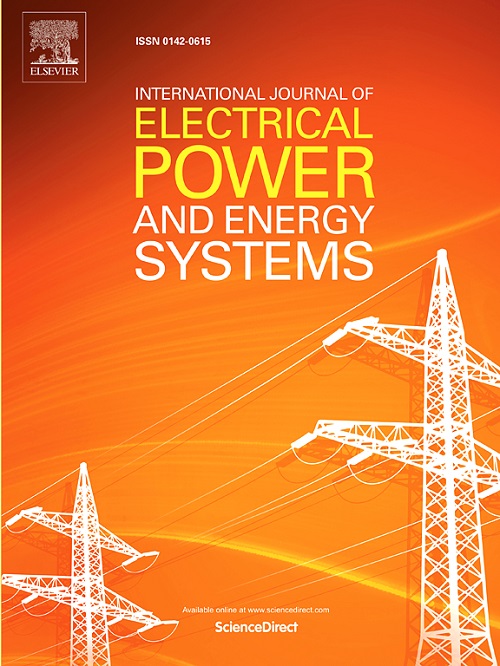时变工况下并网变流器安全运行区域分析
IF 5
2区 工程技术
Q1 ENGINEERING, ELECTRICAL & ELECTRONIC
International Journal of Electrical Power & Energy Systems
Pub Date : 2025-05-14
DOI:10.1016/j.ijepes.2025.110739
引用次数: 0
摘要
大量的工程运行经验表明,并网变流器的性能会随着工作点的变化而发生变化。GCCs的工作点与新能源的波动性和负荷的随机切换等因素密切相关,因此具有时变特性。传统的阻抗/导纳分析方法在固定工作点时分析气相色谱稳定性是有效的,但由于需要跨多个工作点进行重复分析,因此对于时变条件下的系统来说效率低下。对于具有许多潜在操作点的系统,该过程变得特别耗时,最终无法捕获系统在整个操作范围内的行为。因此,目前的研究缺口在于无法有效、全面地分析时变条件下GCC的稳定性,而时变条件是高可再生能源集成系统的共同特征。这一差距至关重要,因为这种波动与可再生能源发电系统高度相关,可能对GCC的稳定性产生重大影响,而缺乏有效的分析方法可能导致这些系统表现不佳甚至失效。为了解决这个问题,本文提出了一个统一的SISO模型,该模型将工作点变量直接嵌入到gcc的小信号分析中。该方法可以在整个gc操作范围内进行稳定性分析,而无需进行冗余评估。此外,该方法将多变量方法的优点与基于安全操作区域(SOR)的稳定性直观表示相结合,为现实时变环境下的稳定性评估提供了一种高效、准确、实用的方法,这是以往研究的难点。构建了一个1.7 kW/60 V的实验样机,实验验证了该方法在静态和时变工况下的准确性和有效性。本文章由计算机程序翻译,如有差异,请以英文原文为准。
Analysis of the safe operation region of grid-connected converters under time-varying operating point conditions
Plenty of engineering operation experience indicates that the performance of grid-connected converters (GCCs) undergoes a transformation in response to alterations in operating points. The operating points of the GCCs are closely related to several factors such as the volatility of new energy and the random switching of loads, therefore exhibit time-varying characteristics. While traditional impedance/admittance analysis methods are effective in analysing the stability of GCCs at fixed operating points, they become inefficient for systems with time-varying conditions due to the requirement of repeat analyses across multiple operating points. This process becomes particularly time-consuming for systems with numerous potential operating points, ultimately failing to capture the system’s behavior over its entire operating range. Therefore, the current research gap lies in the inability to effectively and comprehensively analyse GCC stability under time-varying conditions, which is a common feature of highly renewable energy integrated systems. This gap is critical because such fluctuations are highly relevant to renewable energy generation systems and can significant impact on GCC stability, and the lack of effective analysis methods may lead to underperform or even failure of these systems. To address this, this paper proposes a unified SISO model that embeded operating point variables directly into the small-signal analysis of GCCs. This approach enables stability analysis across the entire operating range of GCCs without redundant evaluations. Additionally, the proposed method integrates the advantages of the multivariate approach with an intuitive representation of stability based on the safe operating region (SOR), offering an efficient, accurate, and practical method for assessing stability in realistic time-varying environments, which has been challenging in previous research. A 1.7 kW/60 V experimental prototype is constructed to experimentally validate the accuracy and effectiveness of the proposed SOR-based method under both static and time-varying operating conditions.
求助全文
通过发布文献求助,成功后即可免费获取论文全文。
去求助
来源期刊
CiteScore
12.10
自引率
17.30%
发文量
1022
审稿时长
51 days
期刊介绍:
The journal covers theoretical developments in electrical power and energy systems and their applications. The coverage embraces: generation and network planning; reliability; long and short term operation; expert systems; neural networks; object oriented systems; system control centres; database and information systems; stock and parameter estimation; system security and adequacy; network theory, modelling and computation; small and large system dynamics; dynamic model identification; on-line control including load and switching control; protection; distribution systems; energy economics; impact of non-conventional systems; and man-machine interfaces.
As well as original research papers, the journal publishes short contributions, book reviews and conference reports. All papers are peer-reviewed by at least two referees.

 求助内容:
求助内容: 应助结果提醒方式:
应助结果提醒方式:


